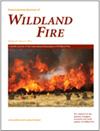澳大利亚志愿消防员的年龄和体育锻炼状况:横断面研究
IF 2.9
3区 农林科学
Q1 FORESTRY
引用次数: 0
摘要
背景 澳大利亚志愿消防员队伍老龄化问题一直备受关注。目的 (1) 确定澳大利亚志愿消防员的年龄分布;(2) 估算符合澳大利亚体育锻炼指南的志愿消防员比例;(3) 调查志愿消防员的年龄与体育锻炼之间的关系。方法 通过电子方式向澳大利亚昆士兰州农村消防队的志愿消防员发放在线调查问卷。调查内容包括人口统计学和体育锻炼问题。调查采用国家指南来确定受访者是否符合澳大利亚的体育锻炼建议。采用贝叶斯方法建立了年龄与每周体育锻炼和每周锻炼分钟数之间的关系模型。主要结果 受访者(n = 480)的年龄中位数为 54 岁。与澳大利亚人口数据相比,志愿消防员达到体育锻炼指南和单纯锻炼指南要求的可能性高出四倍,但未达到强度活动指南要求的可能性高出 1.4 倍。每周体育锻炼分钟数随着年龄的增长而减少,每十年减少 61 分钟。结论 志愿者更有可能达到国家体育锻炼和单纯锻炼指南的要求,但较少可能达到力量型活动指南的要求。启示 志愿消防员可以从促进参与力量型训练的推广计划中获益。本文章由计算机程序翻译,如有差异,请以英文原文为准。
Age and physical activity status of Australian volunteer firefighters: a cross-sectional study
Background There have been concerns of an aging Australian volunteer firefighter workforce. Aims To (1) determine the age distribution of Australian volunteer firefighters; (2) estimate the proportion of volunteer firefighters who met the Australian physical activity guidelines; (3) investigate the relationship between age and physical activity and exercise in volunteer firefighters. Methods An online survey was electronically distributed to Rural Fire Service volunteers in Queensland, Australia. The survey included demographic and physical activity questions. National guidelines were used to determine whether respondents met the Australian physical activity recommendations. The relationships between age and weekly physical activity and weekly exercise minutes were modelled using Bayesian methods. Key results The median age of responders (n = 480) was 54 years. Compared with Australian population data, volunteer firefighters were four times more likely to meet the physical activity guidelines and the exercise-only guidelines, but 1.4 times more likely to not meet the strength-based activity guidelines. Number of weekly physical activity minutes declined with age, by 61 min each decade. Conclusions Volunteers were more likely to meet the national physical activity and exercise-only guidelines, but less likely to meet the strength-based activity guidelines. Implications Volunteer firefighters could benefit from outreach programs that promote participation in strength-based training.
求助全文
通过发布文献求助,成功后即可免费获取论文全文。
去求助
来源期刊
CiteScore
5.50
自引率
9.70%
发文量
67
审稿时长
12-24 weeks
期刊介绍:
International Journal of Wildland Fire publishes new and significant articles that advance basic and applied research concerning wildland fire. Published papers aim to assist in the understanding of the basic principles of fire as a process, its ecological impact at the stand level and the landscape level, modelling fire and its effects, as well as presenting information on how to effectively and efficiently manage fire. The journal has an international perspective, since wildland fire plays a major social, economic and ecological role around the globe.
The International Journal of Wildland Fire is published on behalf of the International Association of Wildland Fire.

 求助内容:
求助内容: 应助结果提醒方式:
应助结果提醒方式:


